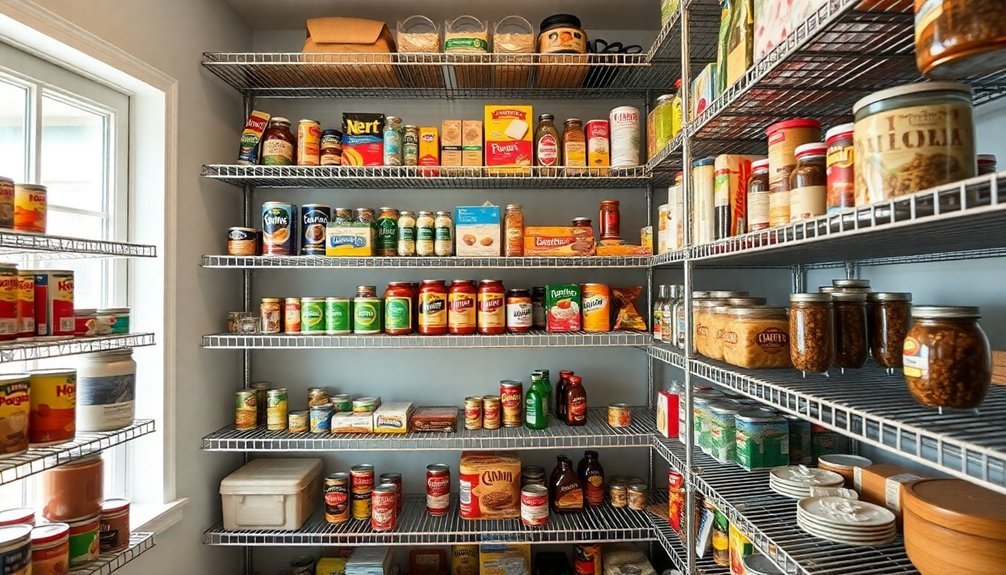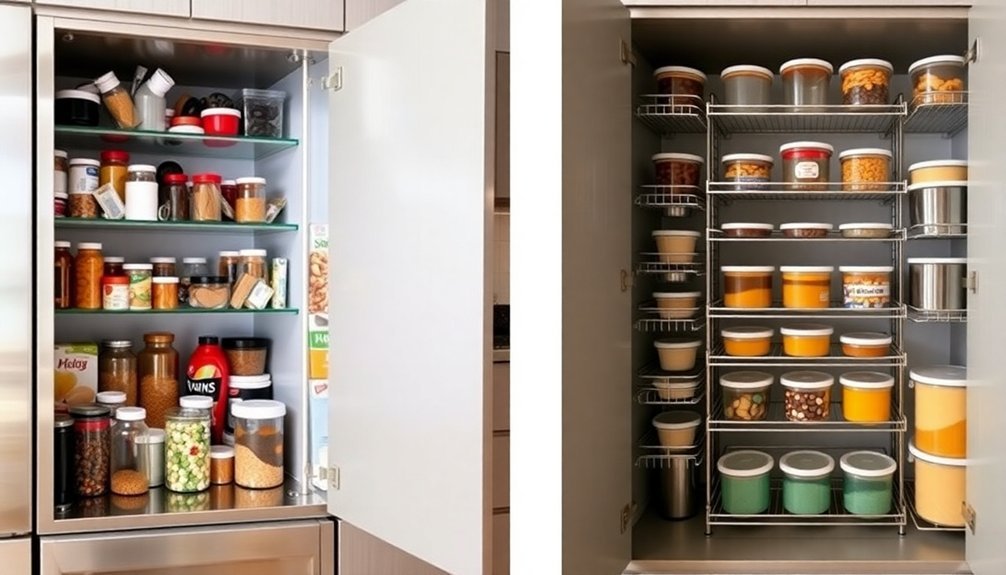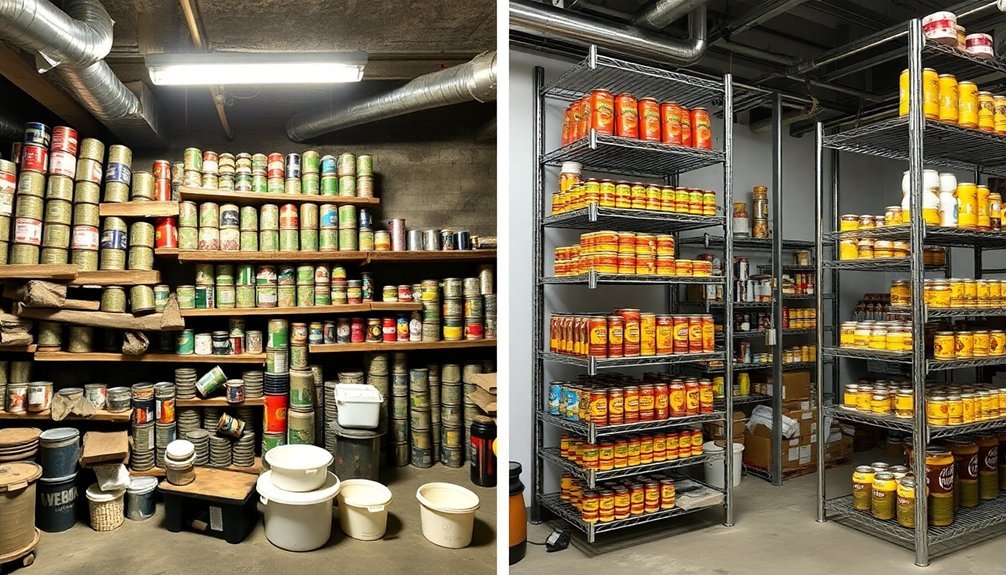Custom food storage racks can transform your kitchen organization while saving up to 40% more space. You'll maximize vertical storage through adjustable shelving that adapts to your specific needs, while door-mounted organizers utilize previously wasted areas. Pull-out racks and lazy Susans make corner items easily accessible, preventing food waste from forgotten items. Modern designs optimize airflow for better temperature control and lower energy costs, while durable materials like stainless steel guarantee long-lasting performance. With costs ranging from $300-$700 per linear foot, your investment delivers efficiency and organization that pays off through reduced waste and improved storage. Let's explore how these innovative solutions can revolutionize your kitchen storage.
Space-Saving Benefits of Custom Racks

Custom storage racks consistently maximize every inch of available space in your home, offering a smart solution for food storage challenges. By utilizing vertical space effectively, you'll transform your storage area from floor to ceiling with adjustable shelving systems that adapt to your specific needs. Installing door-mounted organizers helps utilize previously wasted space while adding extra storage capacity.
These racks let you store less-frequently used items up high while keeping everyday essentials within easy reach. You'll discover countless ways to optimize your space with specialized features like vertical dividers for baking sheets and cutting boards.
Pull-out racks and lazy Susans guarantee you can access items tucked away in corners, while custom-fitted solutions make use of those awkward spaces between appliances that often go unused. With "cansolidators" and angled shelves, you'll maintain better organization of canned goods and other staples.
The beauty of custom racks lies in their adaptability. You can adjust shelf heights to accommodate items of various sizes, install pull-out drawers for easy access, and incorporate rotating trays to maximize corner spaces.
Material Selection for Longevity
When you're selecting materials for your custom food storage racks, you'll need to evaluate how they'll perform in extreme temperatures, from freezing conditions to humid environments.
Regular maintenance will significantly extend the useful life of your storage system and protect your investment. Your best investment often lies in stainless steel or high-grade aluminum, which offer superior durability and corrosion resistance while maintaining their structural integrity across temperature variations.
These materials not only prove cost-effective through their extended lifespan but also support sustainability goals by reducing the need for frequent replacements and maintaining their recyclability at the end of their service life.
Durability in Extreme Temperatures
Throughout the year, selecting the right materials for food storage racks is essential for maintaining their durability in varying temperatures. You'll need racks that can withstand both freezing conditions and high humidity levels, as temperature fluctuations between 70 and 80+ degrees can greatly impact your food quality.
Your storage solutions must be rust and corrosion-resistant, especially in humid environments where moisture levels can exceed 80%. For ideal food preservation, you'll want to maintain temperatures between 50°F and 59°F, while avoiding exposure to extreme heat above 100°F, which can damage canned goods and accelerate spoilage. Regular monitoring systems should be installed to track temperature variations throughout storage areas.
When designing cold storage areas, your racks must handle temperatures as low as 36°F for refrigerated produce and 34°F for meats. You'll need materials that won't deteriorate in these conditions while remaining easy to clean.
Don't forget to take into account ventilation systems that help manage humidity levels effectively. Your storage areas should never exceed 75°F for best food quality.
Avoid placing racks in locations prone to extreme temperatures, such as attics or garages, as these conditions can compromise both your food's safety and your rack's structural integrity.
Cost-Effective Quality Materials
For long-lasting food storage solutions, selecting the right materials doesn't have to break your budget. You'll find that powder-coated steel shelving offers exceptional value, supporting up to 7,200 pounds while resisting corrosion and wear. This durability means you won't need frequent replacements, saving you money in the long run.
If you're looking for a more economical option, wire shelving provides excellent functionality at a lower cost. It's particularly effective in kitchen spaces, supporting 600-800 pounds while promoting airflow that prevents moisture buildup. You can easily customize these units to fit your specific storage needs.
The key to maximizing your investment lies in choosing shelving with smart features. Look for units with clamping adjustment systems and marked poles, which guarantee proper installation and stability.
You'll appreciate features like lip edges that prevent items from falling, especially in earthquake-prone areas. Consider options like the Amazon Basics rack, which combines lightweight design with impressive 750-pound capacity.
For even greater cost efficiency, you can opt for DIY solutions or modular systems that allow you to expand your storage gradually as your needs grow.
Sustainable Material Benefits
Modern storage solutions embrace sustainability without compromising performance. Your custom food storage racks now utilize materials that are 99% renewed, markedly reducing environmental impact while maintaining exceptional durability.
These eco-conscious options feature Eastman Aventa™ Renew materials, which combine wood pulp and recycled content to create storage solutions that won't leave harmful microplastics behind.
You'll benefit from these sustainable features:
- Powder-coated alloy steel construction that supports up to 7,200 pounds while using recycled materials
- Compostable tray options with 43% certified recycled content, suitable for both home and industrial composting
- Integration capabilities with standard ANSI/SLAS dimensions for seamless automation compatibility
The environmental benefits are substantial, with a 61% reduction in eco-costs and a 69% smaller carbon footprint.
You're not just getting storage – you're investing in a solution that's both environmentally responsible and highly functional. The ACT-label certification and impressive Environmental-Impact-Factor score of 23.9 confirm these racks' sustainable credentials.
With adjustable shelving and customizable options, you'll maximize storage efficiency while minimizing environmental impact, making these racks a smart choice for conscious consumers.
Safety Features That Matter

Your racks should include clear labeling systems that make it easy to track receiving dates and use-by information.
Consider incorporating built-in temperature monitoring points where you can easily place and read thermometers.
Look for designs that include secure, lockable sections for high-value items.
The rack configuration should promote accessibility for regular cleaning while maintaining organized, designated spaces that support your food safety management system and make it easier for staff to follow proper storage protocols.
Optimizing Airflow Through Design
Proper airflow stands as a cornerstone of effective food storage rack design. Your custom racks need to facilitate consistent air circulation to prevent temperature fluctuations and maintain food quality.
With well-designed vertical storage and appropriate spacing between shelves, you'll maximize both airflow and storage efficiency while reducing operational costs.
Custom wire shelving and strategic rack placement help you achieve ideal temperature control throughout your storage areas. You're not just storing food; you're protecting it by ensuring even cooling and preventing condensation that could compromise product integrity.
When you invest in proper airflow design, you'll see benefits in both food safety and energy efficiency.
Key advantages of optimized airflow design include:
- Reduced energy costs through efficient cold air circulation
- Prevention of hot spots and temperature inconsistencies
- Enhanced compliance with food safety regulations
Your custom rack design should incorporate elevated platforms and adjustable components that support proper cleaning and maintenance.
Custom Dimensions for Your Kitchen

Precision in kitchen storage design begins with understanding standard cabinet dimensions and how they can be customized to fit your specific needs.
You'll want to take into account how your base cabinets, typically 34.5 inches high without countertops, can support custom racks while maintaining a comfortable working height of 35-36 inches with countertops installed.
When planning your custom storage racks, you'll need to work within the standard depths of 24 inches for base cabinets while maximizing vertical space.
Wall cabinets, installed 18 inches above base units, offer additional opportunities for custom rack solutions within their 12-24 inch depths.
You can take advantage of tall cabinet spaces, which range from 84 to 96 inches in height, to create floor-to-ceiling storage systems.
For pantry and utility spaces, you'll find the most flexibility for custom rack installations.
With depths averaging 24 inches and heights that can extend from floor to ceiling, you can design storage solutions that accommodate everything from small containers to bulk purchases.
Take into account incorporating adjustable racks within these spaces to adapt to your changing storage needs while maintaining proper airflow and accessibility.
Cost Analysis and ROI
While investing in custom storage racks requires careful financial planning, understanding the costs and potential returns can help you make informed decisions.
You'll need to evaluate both material and labor costs, with materials ranging from $300 to $700 per linear foot, depending on your choice of wood or other materials. Labor and installation typically add 30-50% to your material costs, plus potential permit and demolition expenses.
Your investment in custom storage can include various efficiency-boosting features:
- Rollout trays ($150-$400) and dovetail drawers ($100-$300) for easy access
- Specialized shelving units ($100-500) for specific storage needs
- Soft-close hinges ($20-$50) and custom hardware for durability
While the upfront costs might seem substantial, you'll find significant returns through improved food storage efficiency and reduced waste.
Custom racks help you implement first-in, first-out systems, making it easier to rotate your food supplies and prevent spoilage. You'll maximize your available space by utilizing previously awkward areas, like spaces between appliances or under-utilized vertical storage.
Over time, these improvements in organization and accessibility can offset your initial investment through reduced food waste and better inventory management.
Installation and Maintenance Tips

You'll need basic tools like a level, drill, and measuring tape for a quick and proper setup of your food storage racks.
Keep your racks in top condition by conducting monthly inspections for stability, cleanliness, and signs of wear.
Clean the shelves and surrounding areas regularly while checking for loose anchors, damaged components, or any safety hazards that could compromise your storage system.
Clean and Inspect Monthly
Maintaining custom food storage racks requires three key monthly tasks: cleaning, inspection, and organization.
You'll need to clean spills immediately and regularly wipe down all surfaces, including dollies, carts, and shelving, using gentle non-abrasive solutions to protect the finish. Keep the airflow consistent by ensuring proper spacing between items and checking ventilation systems.
Monthly inspections should focus on these vital areas:
- Temperature and humidity levels (maintain 50-70°F)
- Structural integrity, including weight distribution and shelf damage
- Signs of moisture problems or pest intrusion
Your organization system plays a significant role in rack maintenance.
Keep a 6-inch gap between stored items and walls, and maintain 12 inches of clearance from the ceiling. You'll want to use clear labeling systems and proper storage containers like baskets, crates, and glass jars to maximize efficiency.
Don't forget to check that horizontal supports and dividers are secure and functioning correctly.
Regular maintenance prevents costly repairs and extends your rack system's lifespan.
Tools for Quick Setup
A successful food storage rack installation starts with having the right tools and materials on hand.
You'll need a power saw for precise wood cuts, a drill for creating screw holes, and a tape measure with a pencil for accurate markings. Don't forget your nail gun or hammer with finishing nails for assembly.
For materials, gather plywood or OSB board as your main structure, along with 1x4s and 1x2s for supports. You'll also need 2x4s for the base, screws for securing components, and wood glue to reinforce joints. These materials guarantee your rack's durability and stability.
Before installation, locate wall studs and verify you'll attach the rack to at least one, preferably two. You'll want to maintain level positioning throughout installation to prevent tipping.
Install horizontal supports at the top and bottom, and don't forget the bottom baseboard to keep cans secure.
To customize your rack, space vertical supports according to your can sizes. You can add adjustable shelves for flexibility and wedges to improve can rotation.
Remember to test the rack's functionality before final installation, confirming smooth can movement and overall stability.
Frequently Asked Questions
Can Custom Racks Be Relocated if I Move to a Different Kitchen?
Yes, you can relocate your custom racks when moving kitchens. They're designed to be versatile and adaptable. Just guarantee proper planning, careful disassembly, secure transport, and professional reinstallation at your new location.
Do Custom Racks Affect My Kitchen's Resale Value?
Yes, custom racks can boost your kitchen's resale value. You'll see both aesthetic and functional benefits that attract buyers, with potential ROI up to 85.7% on cabinet upgrades when you sell your home.
How Long Does the Custom Rack Design and Manufacturing Process Take?
You'll typically wait 4-6 weeks for your custom racks. Urgent orders can be ready in 4 weeks, while complex designs may take longer. The timeline depends on your specifications and material availability.
Are Permits Required for Installing Commercial-Grade Custom Storage Racks?
Yes, you'll need permits for commercial storage racks, especially if they're over 5'9" tall. Building permits, fire permits, and high-piled storage permits are required, depending on your rack height and storage area.
Can Existing Shelving Systems Be Modified to Integrate With Custom Racks?
Yes, you can modify your existing metal shelving to integrate custom racks. You'll be able to add angled can rotation shelves while keeping the original flat shelves, creating an efficient storage system for your needs.
In Summary
Custom storage racks aren't just an upgrade – they're a necessity for your modern food storage needs. You'll maximize your space, protect your investments, and guarantee proper food preservation with the right materials and design. When you factor in the long-term savings, improved organization, and enhanced safety features, custom racks deliver clear value. Don't wait to transform your storage system – start planning your custom solution today.





Leave a Reply